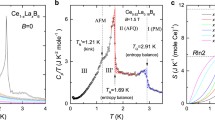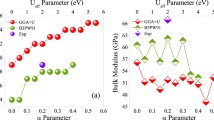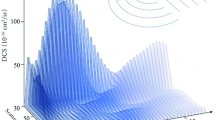Abstract:
We present a theoretical model of the “isostructural" γ–α phase transition in Ce which is based on quadrupolar interactions due to coupled charge density fluctuations of 4f electrons and of conduction electrons. The latter are treated in tight-binding approximation. The γ–α transition is described as an orientational ordering of quadrupolar electronic densities in a \(Pa\overline 3 \)structure. The quadrupolar order of the conduction electron densities is complementary to the quadrupolar order of 4f electron densities. The inclusion of conduction electrons leads to an increase of the lattice contraction at the γ–α transition in comparison to the sole effect of 4f electrons. We calculate the Bragg scattering law and suggest synchrotron radiation experiments in order to check the \(Pa\overline 3 \) structure.
Similar content being viewed by others
Author information
Authors and Affiliations
Additional information
Received 21 September 1999 and Received in final form 2 May 2000
Rights and permissions
About this article
Cite this article
Nikolaev, A., Michel, K. Electric quadrupole interactions and the γ–α phase transition in Ce: the role of conduction electrons. Eur. Phys. J. B 17, 15–32 (2000). https://doi.org/10.1007/s100510070156
Issue Date:
DOI: https://doi.org/10.1007/s100510070156




